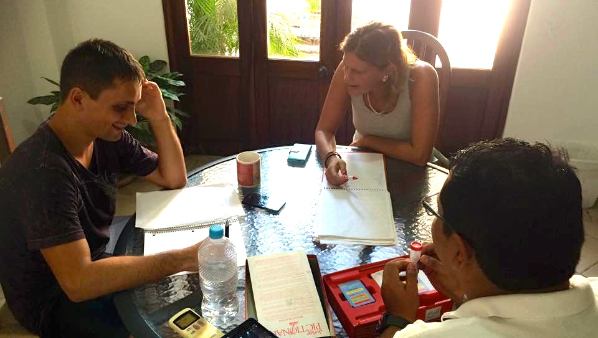ITTO's TEFL Course is one of the most competitive, challenging, and internationally certified courses accessible anywhere in the world. This is how the course is structured: It consists of 140 hours (20 hours more than required by international standards) spread over four weeks, Monday through Friday from 9:00 AM to 5:00 PM. Our program exceeds worldwide standards, which is why businesses prefer our graduates over those from other institutions.
Your course will use the most current approaches, such as blended learning, the use of technology in the classroom, the use of apps in EFL/ESL, and content language integrated learning (CLIL).
- These 120 hours are divided into the following categories:
- 120-hour Session of Content Input
- 6 hours of observed teaching practicum
- 6 hours of observation with senior teachers
- Teaching 1 private tutoring class
Monday to Friday:
- 9:00 a.m. to 1:00 p.m. Input sessions covering grammar, phonetics, teaching skills, and classroom management
- 1:00 p.m. to 2:00 p.m. Lunch
- 2:00 p.m. to 4:00 p.m. Guided lesson preparation time
- 3:15 p.m. to 5:15 p.m. Class observation or teaching practice
The course is divided into five areas:
1. Classroom Management
Among the subjects discussed are the following:
- The teacher's responsibility in fostering an effective learning environment.
- Promoting student engagement as a means of instruction in relation to the teacher's responsibility within a communicative education framework.
- Classroom management tactics that work. The significance of eye contact, body language, voice projection, grouping students, lesson preparation, developing relationships with students, and utilizing physical space as a teaching resource.
- Both production and display of images are required: the board, flash cards, and drawing, for example.
- Managing groups of pupils of varying ages requires an understanding of discipline and behavioral tendencies.
- Instructions.
- Monitoring.
- Appropriately praising and delivering feedback.
2. Teaching Skills
This is a highly practical component of the course during which trainees discuss the following:
- How to create a complete lesson plan.
- Prior to teaching grammar and vocabulary, it is necessary to understand the structure of the language.
- Vocabulary instruction strategies.
- How to respond correctly to kids' errors.
- The unique requirements of beginners, intermediate students, and advanced pupils.
- Using games as an effective teaching technique in the classroom.
- The incorporation of communicative activities within the contemporary educational paradigm.
- Language as a collection of abilities (speaking, reading, listening and writing).
- Grammar instruction using an inductive and deductive approach.
- English for Specific Purposes Instruction.
- The principles that govern effective evaluation.
3. Language Awareness (Grammar)
This component of the course is designed to reinforce trainees' knowledge of the English grammar system and to provide practical suggestions for teaching it.
Several different parts of grammar are explored, including the following:
- Tenses: their structure, meaning, and application
- Adjectives and nouns
- Verbs and adjectival phrases. Forms of verbs (infinitives, gerunds, etc.)
- Components of speech
- Auxiliary verbs in the modal mode
- Conditionals
- Clauses that are relative
- Verbs with phrasal endings
- Pronunciation, intonation, and word/sentence stress instruction
- Phonetics
4. Phonology
This section discusses stress, intonation, and rhythm. Trainees will focus primarily on the practical consequences of these issues in relation to the teaching of English language musicality, drill, and expressivity in comparison to the learners' native language.
5. Teaching Practice
This is the most practical and critical component of the training. Trainees teach authentic EFL students while adhering to an established curriculum; this is critical, as many other training institutions worldwide seek volunteers for trainees' teaching practices or perform these practices among the trainees.
All teaching activities are observed, constructively critiqued, and graded by our trainers for a minimum of ten hours (six being the international standard). The emphasis is on growth, and trainees are expected to handle feedback-related concerns.
Our exit criteria are as follows:
The First Week:
1. At the conclusion of session one, trainees will be aware of the following:
- The factors that influence people's decision to learn a foreign language.
- Numerous hypotheses exist regarding how people efficiently learn.
- The distinctions between acquisition and learning of a language.
- The characteristics that contribute to language acquisition and learning success.
2. By the end of session two, trainees will be familiar with the following:
- The teacher's role in fostering effective learning.
- A teacher's characteristics that make him or her effective.
- The decisions that teachers must make when managing a class.
- The aspects that influence the teacher's decision-making process.
- In the classroom, strategies for increasing student-teacher interaction (STT) are discussed.
- The various ways that teachers can unintentionally obstruct or inhibit learning.
3. At the conclusion of session three, trainees will be familiar with the following:
Classroom management strategies involving eye contact, gestures, voice, grouping of students, pre-lesson preparation, connection with students, and behavior management.
Presentation skills are required for resources such as the board, the flip chart, pre-prepared cards, and note pads.
The application of audiovisual equipment and technology, such as a projector, tablets, CD players, and interactive white boards.


 ITTO School's Map
ITTO School's Map MEXICO
MEXICO Guadalajara
Guadalajara Puerto Vallarta
Puerto Vallarta Chiapas
Chiapas Playa del Carmen
Playa del Carmen ARGENTINA
ARGENTINA Buenos Aires
Buenos Aires ITALY
ITALY Florence
Florence CANADA
CANADA Toronto
Toronto Vancouver
Vancouver CHINA
CHINA Shanghai
Shanghai COSTA RICA
COSTA RICA Manuel Antonio
Manuel Antonio Playa Samara
Playa Samara CZECH REPUBLIC
CZECH REPUBLIC Prague
Prague FRANCE
FRANCE Toulouse
Toulouse GUATEMALA
GUATEMALA Antigua
Antigua PERU
PERU Cusco
Cusco SPAIN
SPAIN Barcelona
Barcelona Madrid
Madrid THAILAND
THAILAND Chiang Mai
Chiang Mai USA
USA New York
New York Chicago
Chicago Miami
Miami Online TEFL Programs
Online TEFL Programs Compare Course Features
Compare Course Features














